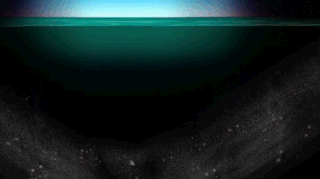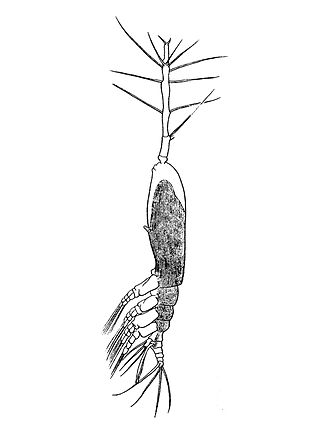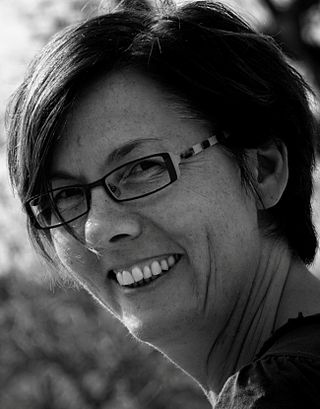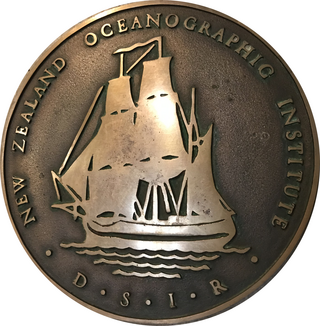
Copepods are a group of small crustaceans found in nearly every freshwater and saltwater habitat. Some species are planktonic, some are benthic, a number of species have parasitic phases, and some continental species may live in limnoterrestrial habitats and other wet terrestrial places, such as swamps, under leaf fall in wet forests, bogs, springs, ephemeral ponds, puddles, damp moss, or water-filled recesses of plants (phytotelmata) such as bromeliads and pitcher plants. Many live underground in marine and freshwater caves, sinkholes, or stream beds. Copepods are sometimes used as biodiversity indicators.

Diel vertical migration (DVM), also known as diurnal vertical migration, is a pattern of movement used by some organisms, such as copepods, living in the ocean and in lakes. The adjective "diel" comes from Latin: diēs, lit. 'day', and refers to a 24-hour period. The migration occurs when organisms move up to the uppermost layer of the water at night and return to the bottom of the daylight zone of the oceans or to the dense, bottom layer of lakes during the day. DVM is important to the functioning of deep-sea food webs and the biologically-driven sequestration of carbon.

The World Association of Copepodologists (WAC) is a non-profit organization created to promote research on copepods by facilitating communication among interested specialists.
Hemiboeckella powellensis, is a zooplankton copepod of which only four of its kind have ever been observed. "Hemiboeckella" refers to this genus being a subvariant of Boeckella, whilst “powellensis” refers to Lake Powell in Western Australia, the region it is endemic to. Its existence was initially recorded in May and June 1977, and has not been observed since.

Monstrilloida is an order of copepods with a cosmopolitan distribution in the world's oceans. The order contains a single family, Monstrillidae. The name of the first ever described genus Monstrilla is derived from latin, meaning "tiny monster", because the lack of usual diagnostic features of copepods puzzled early taxonomists.

The San Francisco Estuary together with the Sacramento–San Joaquin River Delta represents a highly altered ecosystem. The region has been heavily re-engineered to accommodate the needs of water delivery, shipping, agriculture, and most recently, suburban development. These needs have wrought direct changes in the movement of water and the nature of the landscape, and indirect changes from the introduction of non-native species. New species have altered the architecture of the food web as surely as levees have altered the landscape of islands and channels that form the complex system known as the Delta.

Acartiidae is a family of calanoid copepods distinguishable by the rostral margin not being extended. They are epipelagic, planktonic animals, not being found below a depth of 500 metres (1,600 ft). There are over 100 described species distributed throughout the world's oceans, mainly in temperate areas.
Acartia hudsonica is a species of marine copepod belonging to the family Acartiidae. Acartia hudsonica is a coastal, cold water species that can be found along the northwest Atlantic coast.
Acartia simplex is a species of marine copepod belonging to the family Acartiidae. It is found in the waters near Australia and New Zealand.
Acartia tonsa is a species of marine copepod in the family Acartiidae.

Bettina Meyer is a German Antarctic researcher, best known for her work on the ecology and physiology of invertebrates in the pelagic zone. She is the head of the ecophysiology of pelagic key species working group at the Alfred Wegener Institute for Polar and Marine Research (AWI).
Mildred Stratton Wilson was an American zoologist, whose work on copepods was awarded a Guggenheim Fellowship in 1955.
Mark D. Ohman is an American Biological Oceanographer. He is Distinguished Professor of the Graduate Division at the Scripps Institution of Oceanography, University of California, San Diego. He is Director and Lead Principal Investigator of the California Current Ecosystem Long-Term Ecological Research site, supported by the U.S. National Science Foundation.

Nancy Helen Marcus was an American biologist and oceanographer. During her graduate studies, Marcus became known as an expert on copepod ecology and evolutionary biology. She began her career as a postdoctoral fellow at the Woods Hole Oceanographic Institution where she studied copepod dormancy and its implications for marine aquaculture. She continued her field research as a professor of oceanography and later as the director of the Florida State University Marine Laboratory (FSU). During this time Marcus was elected as a Fellow of the Association for Women in Science and the American Association for the Advancement of Science and served as the president of the Association for the Sciences of Limnology and Oceanography. As the president, she led efforts in increase education activities and to increase the endowment fund.
Neocalanus cristatus is a species of copepod found primarily in the northern Pacific.

The lipid pump sequesters carbon from the ocean's surface to deeper waters via lipids associated with overwintering vertically migratory zooplankton. Lipids are a class of hydrocarbon rich, nitrogen and phosphorus deficient compounds essential for cellular structures. This lipid carbon enters the deep ocean as carbon dioxide produced by respiration of lipid reserves and as organic matter from the mortality of zooplankton.

The New Zealand Oceanographic Institute (NZOI) was a department within the Division of Marine and Freshwater Science, as part of the Department of Scientific and Industrial Research (DSIR).
Ronald Allan Heath, is a retired oceanographer and university administrator. His research focus was on the physical oceanography of the oceans around New Zealand.
Candacia worthingtoni is a species of copepod in the order Calanoida first described by George Grice in 1981 under the basionym Paracandacia worthingtoni. The species is named for the scientist emeritus Valentine Worthington, as a tribute to his contributions to the field of physical oceanography.

Ann Bucklin is Professor Emeritus of Marine Sciences at the University of Connecticut known for her work using molecular tools to study zooplankton. Bucklin was elected a fellow of the American Association for the Advancement of Science in 1995.














